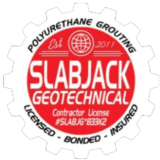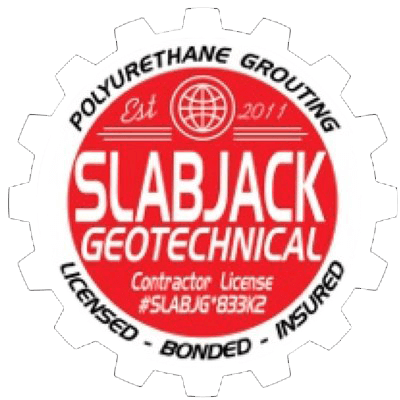
There are several different ways to raise settled concrete. Mudjacking, sand jacking, concrete pressure grouting and polyurethane Slabjacking.
A brief overview –
There are several recipes for mudjacking. Most companies using this method use a mix of native dirt mixed with a little bit of fly ash and a touch of Portland cement mixed with water. Portland cement of course creates a stiff material as it dries out and the fly ash helps the material flow through the hose without clogging. There are other recipes and the goal is to have a consistent product that flows through the pump hose without “dry packing” and doesn’t shrink too much as it dries.
Sandjacking can be done only when the slab can be pre-positioned with jacks at which point dry sand is blown under the slab to fill the void space. This method is time consuming and impossible for much of the settled concrete out there due to the inability to use jacks against walls and such.
Concrete pressure grouting is another method that is it occasionally attempted. The problem with this method is the incredible overburden on week soils concrete creates. At thirty three hundred pounds per square yard it doesn’t take much material to have the equivalent of a full-size pick up truck sitting under your concrete slab trying to hold it up. Concrete pressure grouting is a horrible way to raise concrete and generally results in additional resettling followed by having to rip it all out and replace it at a later date.
Polyurethane slab jacking is known by several names such as the Uretek method, polylevel, polylift, geo-polymer Slabjacking and more. What they all have in common is using an expanding polymer to raise concrete. Available in fairly light duty formulations all the way up to extremely heavy duty formulations for residential, commercial, trench break foam, slab curl stabilization polymers and soil stabilization materials. The primary advantage of using polyurethane is you eliminate the inconsistency of the Slabjack material. In addition the material flows better under the concrete slab, much smaller holes are needed to inject the material through the slab and it is a faster process which helps negate the higher material cost.
Several polymer manufacturers produce material. NCFI, HMI, SPI and others are leaders in the manufacture of slab lifting polymers. The polymers are categorized by weight per square-foot but “rise time” is a critical factor to determine suitability for residential or commercial lifting. Two different polymers both four pounds per square foot may have very different lifting characteristics with one moving large distances under the slab and the other aggressively lifting in a very limited area. One would be a good choice for a large freeway slab but completely wrong for a residential sidewalk. In addition the temperature of the material and the substrate play important roles in the technique used to raise the concrete slab.
Call the experts at 1-855-752-2522 today for an on-site estimate to have your settled concrete raised.
1-855-752-2522
www.SlabjackGeotechnical.com















4 comments
Linda pera
June 27, 2019 at 9:20 am
Do you have contractors that use this material
In 19034 area?
Jerald Sargent
June 27, 2019 at 10:28 am
Where specifically are you located?
sealboss
June 26, 2020 at 5:47 pm
https://sealboss.com/seawall-repair-bulkhead-repair-erosion-control-permeation-grouting/
Your podcast is live
Jerald Sargent
February 15, 2021 at 7:30 pm
Washington state.